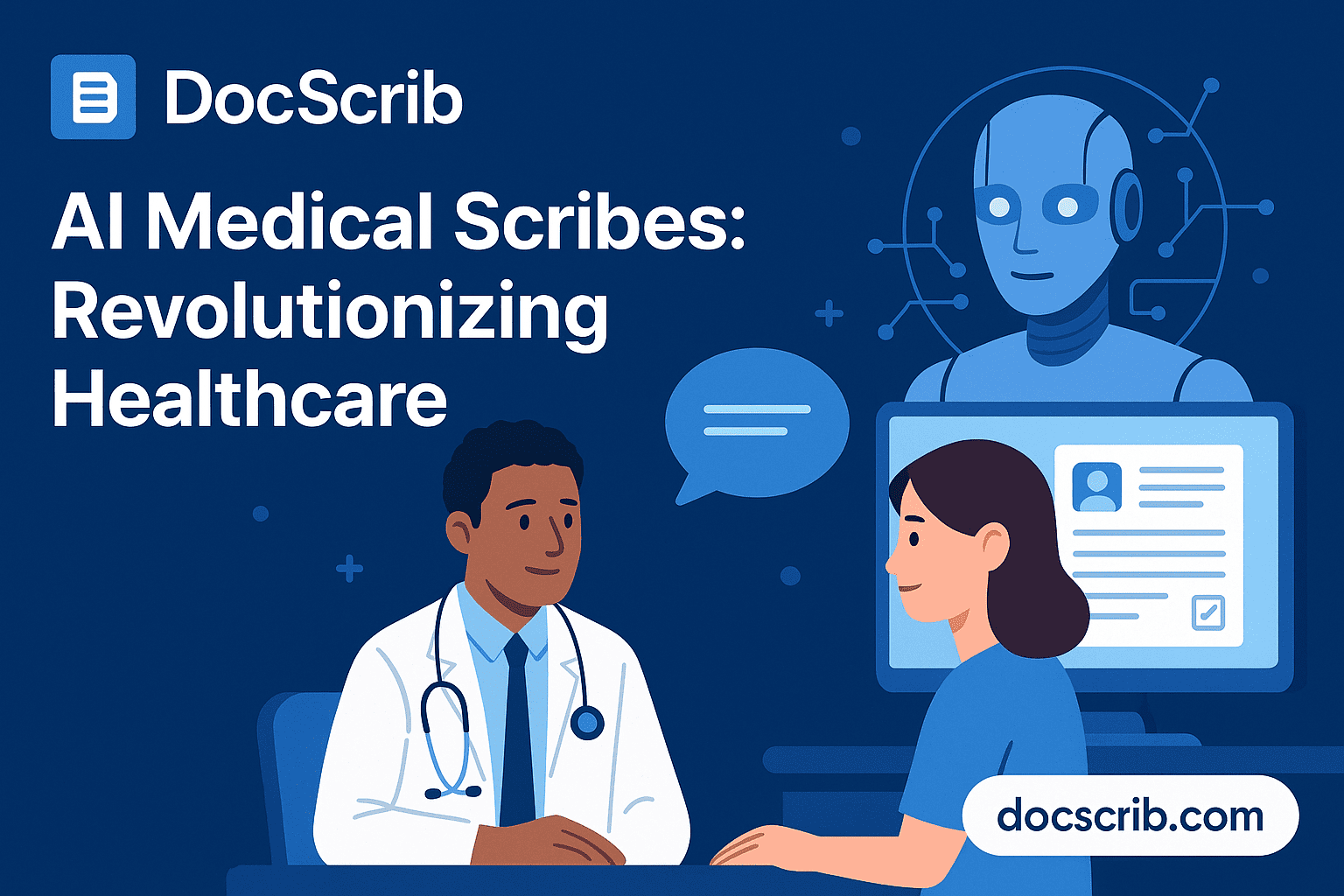Updated on: July 11, 2025
The healthcare industry is undergoing a seismic shift, and at the heart of this transformation lies Artificial Intelligence (AI). From virtual medical scribes to predictive diagnostics and robotic surgery, AI is revolutionizing healthcare in ways that were once thought impossible.
One of the most impactful innovations making waves today is the rise of AI medical scribes—intelligent tools that are streamlining clinical documentation, reducing burnout, and enhancing patient care.
In this article, we’ll dive deep into:
-
What AI medical scribes are
-
How they’re revolutionizing healthcare
-
Real-world benefits for clinics and hospitals
-
How DocScrib is leading this digital transformation
👉 Book a free demo of DocScrib and experience the future of clinical documentation.
What Are AI Medical Scribes?
An AI medical scribe is an intelligent, software-based assistant that listens to the patient-clinician conversation, automatically transcribes it into structured clinical notes, and integrates those notes directly into the Electronic Health Record (EHR) system.
Unlike traditional virtual medical scribes who manually type notes, AI scribes like DocScrib use Natural Language Processing (NLP) and Machine Learning (ML) to:
✅ Capture the dialogue
✅ Extract relevant medical information
✅ Generate accurate, compliant notes in real time
The result? Clinicians get their time back, documentation becomes seamless, and patient care improves.
How AI Medical Scribes Are Revolutionizing Healthcare
1. Reducing Physician Burnout
Physicians today spend an average of 1–2 hours on EHR tasks for every hour of patient care. This documentation burden leads to:
-
Increased stress
-
Decreased job satisfaction
-
Higher turnover
AI medical scribes automate charting, enabling clinicians to focus on what they do best: caring for patients.
2. Improving Clinical Efficiency
AI scribes streamline workflows by:
-
Reducing after-hours charting
-
Speeding up documentation time by up to 70%
-
Allowing clinicians to see more patients without compromising care quality
3. Enhancing Patient Experience
With less time spent on computers, clinicians can:
-
Maintain better eye contact
-
Build stronger relationships with patients
-
Increase patient satisfaction scores
4. Ensuring Compliance and Accuracy
AI scribes like DocScrib generate:
-
Structured, audit-ready notes
-
Accurate, consistent documentation
-
Compliance with HIPAA and healthcare standards
👉 See how DocScrib helps you stay compliant and efficient.
How Does an AI Medical Scribe Work?
Here’s a simple breakdown of how DocScrib works in real-world clinical settings:
| Step | What Happens |
|---|---|
| Data Capture | AI listens to real-time patient-physician conversations. |
| Speech-to-Text Conversion | Converts spoken language into text using advanced NLP. |
| Clinical Note Creation | Structures the information into SOAP notes, HPI, Assessment & Plan. |
| EHR Integration | Notes are securely transferred into the clinic’s EHR system. |
| Clinician Review | Doctors can review, edit, and approve the notes with minimal effort. |
👉 Schedule a personalized demo to see DocScrib in action.
AI Medical Scribes vs. Virtual Medical Scribes: What’s the Difference?
| Feature | AI Medical Scribes (DocScrib) | Virtual Medical Scribes (Human) |
|---|---|---|
| Speed | Instant, real-time documentation | Delayed due to human transcription |
| Cost | Lower, no labor fees | Higher due to staffing |
| Privacy & Security | HIPAA-compliant, no human exposure | Potential third-party data access |
| Scalability | Easily scalable across multiple locations | Limited by human resource capacity |
| Accuracy | Continuously improving through AI learning | Human error and variability |
In short, AI medical scribes are faster, more cost-effective, and more secure.
Real-World Benefits of AI Medical Scribes for Clinics & Hospitals
✅ Time Savings: Up to 2 hours saved per clinician daily
✅ Revenue Growth: Ability to see more patients without additional admin work
✅ Better Work-Life Balance: Reduced after-hours charting
✅ Improved Compliance: Standardized documentation meets regulatory requirements
✅ Patient-Centric Care: More face-to-face interaction and less screen time
Who Should Consider AI Medical Scribes?
AI scribes are a smart fit for:
-
Clinicians in Primary Care
-
Specialists (Psychiatry, Cardiology, Neurology, etc.)
-
Hospitals and Group Practices
-
Telehealth Providers
-
Urgent Care Centers
If documentation takes too much of your time, DocScrib can help.
👉 Learn more about AI scribes and how they work: Visit DocScrib.
The Future of AI Medical Scribes in Healthcare
The rise of AI in healthcare is just beginning. The future will bring:
-
Fully automated documentation workflows
-
Predictive charting and clinical decision support
-
AI-powered patient education and follow-up
By adopting solutions like DocScrib today, healthcare providers can stay ahead of the curve and deliver better care with less stress.
Key Takeaways
✅ AI Medical Scribes are transforming healthcare by automating documentation and reducing burnout.
✅ Solutions like DocScrib enhance clinical efficiency, improve patient care, and ensure compliance.
✅ The future of healthcare is AI-driven, and the time to embrace it is now.
👉 Book your demo with DocScrib and start your journey toward a smarter, more efficient clinic.
